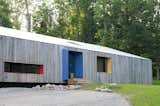Collection by Sara Ost
The Windows Have It
From classic, cool glass swaths to a glowing semi-opaque wall to a crowning oculus of light, we've rounded up a selection of some of the most distinctive and diverse windows from homes featured in Dwell.
Don't miss a word of Dwell! Download our FREE app from iTunes, friend us on Facebook, or follow us on Twitter!
The Pine Plains, New York, home of Elise and Arnold Goodman boasts 48 windows, the largest of which measures 8'6'' by 7'6''. As architect Preston Scott Cohen explains, the "free facade makes it impossible to identify how many levels there are, or even to tell the difference between a door and a window." From without, the windows reveal dramatic glimpses of the 18th-century barn farm and new steel structure that support the house. From within, says Elise, "Each season, each time of day, offers a different view of the world. It's spectacular."
Los Angeles–based graphic designer Chris Loomis created a trio of window
decals for the house’s three bathrooms. Grunbaum went with a camouflage pattern for privacy in the master bathroom, which has a wall of floor-to-ceiling glass that looks onto an adjacent patio. “Because we’re sort of in the trees, I wanted to keep the plant theme going,” he says. laloomis.com
Like most Northern California homes built in the 1960s, the Burnett residence originally acted like a sieve, letting air and heat easily pass through its uninsulated walls and single-pane windows. The design team replaced all of the windows with double-pane glass, which works wonders to hold in the heat.










